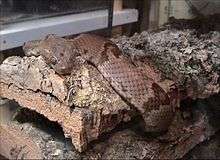Trimorphodon biscutatus vilkinsonii
| Texas lyre snake | |
|---|---|
 | |
| Scientific classification | |
| Kingdom: | Animalia |
| Phylum: | Chordata |
| Class: | Reptilia |
| Order: | Squamata |
| Suborder: | Serpentes |
| Family: | Colubridae |
| Genus: | Trimorphodon |
| Species: | T. biscutatus |
| Subspecies: | T. b. vilkinsonii |
| Trinomial name | |
| Trimorphodon biscutatus vilkinsonii Cope, 1886 | |
| Synonyms | |
|
Trimorphodon vilkinsonii | |
The Texas lyre snake (Trimorphodon biscutatus vilkinsonii) is a subspecies of mildly venomous rear-fanged colubrid. The epithet vilkinsonii is in honor of amateur American naturalist Edward Wilkinson, who collected the first specimen near the city of Chihuahua. Some sources consider it to be its own species (Trimorphodon vilkinsonii).
Geographic range
It is found in the United States in the Big Bend region of Texas and southern New Mexico, and in Mexico in northeastern Chihuahua.
Description
They are medium-sized snakes, attaining lengths of approximately 1 meter (39 inches) at adult size.[1] They are brown, tan or gray with 17-24 dark brown blotches down the back. They have large eyes with vertical pupils. The common name, lyre snakes, comes from a distinctive V shaped pattern on the head which resembles the shape of a lyre. However, it should be noted that this particular subspecies (T. b. vilkinsonii) has no V mark on the head.[2]
Behavior
Lyre snakes are nocturnal, spending most of their time hiding in rock crevices, emerging to feed mainly on lizards,[3] and also on small rodents, frogs, bats and birds.[4] Their venom is not considered to be harmful to humans. Also, if their venom is not fatal to their prey, they may kill by constriction.[5]
Reproduction
Lyre snakes are oviparous, laying about a dozen eggs per clutch.[6]
References
- Species Trimorphodon biscutatus at The Reptile Database
- ↑ Wright, A.H. and A.A. Wright. 1957. Handbook of Snakes of the United States and Canada. Comstock. Ithaca and London.
- ↑ Smith, H.M. and E.D. Brodie, Jr. 1982. Reptiles of North America: A Guide to Field Identification. Golden Press. New York.
- ↑ Schmidt, K.P. and D.D. Davis. 1941. Field Book of Snakes of the United States and Canada. G.P. Putnam's Sons. New York.
- ↑ Conant, Roger. 1975. A Field Guide to Reptiles and Amphibians of Eastern and Central North America. Houghton Mifflin. Boston.
- ↑ Rodman,G.B. 1939. Habits of Trimorphodon vandenburghi in Captivity. Copeia, 1939,p. 50.
- ↑ Schmidt, K.P. and D.D. Davis. Field Book of Snakes of the United States and Canada. G.P. Putnam's Sons. New York.